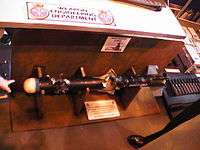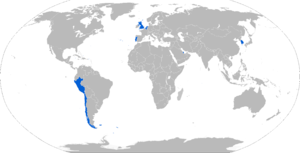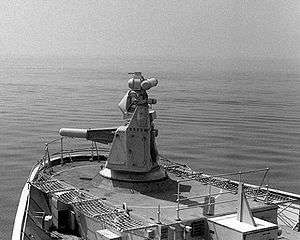Goalkeeper CIWS
| Goalkeeper CIWS | |
|---|---|
|
Goalkeeper CIWS on a British Invincible-class aircraft carrier | |
| Type | Close In Weapons System |
| Place of origin | Netherlands |
| Service history | |
| In service | 1980–present |
| Used by | See operators |
| Production history | |
| Designer | Signaal (now Thales Nederland) |
| Designed | 1975 |
| Manufacturer | Thales Naval Netherlands |
| Produced | 1979 |
| Specifications | |
| Weight | 6,372 kg (14,048 lb) with 1,190 rds of ammunition (above deck); 9,902 kg (21,830 lb) (total), assuming 1 g. |
| Height | 3.71 m (above deck) 6.2 m (including deck penetration). |
| Crew | Automated, with human oversight |
|
| |
| Shell | 30×173mm TP, HEI, MPDS, or FMPDS |
| Caliber | 30 mm |
| Barrels | 7-barrel (progressive RH parabolic twist, 14 grooves) |
| Elevation | +85 to −25 degrees at 80 degree/s |
| Traverse | Unlimited |
| Rate of fire | 70 rounds/second (4,200 rounds/minute) |
| Muzzle velocity | 1,109 m/s (MPDS round) |
| Effective firing range | 350 to between 1,500 and 2,000 meters dependent on ammunition |
|
| |
Main armament | 1 x GAU-8/A Avenger 30 mm seven-barrel Gatling gun |
Goalkeeper is a Dutch close-in weapon system (CIWS) introduced in 1979. It is an autonomous and completely automatic weapon system for short-range defence of ships against highly maneuverable missiles, aircraft and fast maneuvering surface vessels. Once activated the system automatically undertakes the entire air defense process from surveillance and detection to destruction, including selection of the next priority target.
Development
Development of the system began in 1975 with Holland-Signaal (now Thales Nederland) working with General Dynamics, which supplied the GAU-8 gun. A prototype, the EX-83, was first demonstrated to the Royal Netherlands Navy in 1979.
In 2012 the Dutch ministry of defense announced that the Goalkeeper systems in use by the Netherlands Navy will receive radar upgrades, mechanical improvements, new high-precision frangible ammunition and a new electro-optical tracking system. Also the system's surface mode will be improved to counter high speed boats and fast attack craft. These upgrades will make the system more capable to defend ships against the latest threats such as modern anti-ship missiles, more effective in littoral environments and less vulnerable to malfunctions. It also expands the life of the system to at least 2025. The first of 16 systems will be upgraded and tested by Thales Nederland, the others at the naval base in Den Helder.[1]
Description
Target selection
Goalkeeper has two radar sub-systems, one to find threats and another to track and engage them, which operate together to identify and prioritise targets, and engage the highest priority one.
The 2D I band search radar, which can handle up to 18 targets at once, generates a threat picture which the gun system uses to identify and prioritize threats. The system has identify friend or foe (IFF) functionality to rule out friendly traces.[2] The tracking radar operates in both I band and K band to enable quick acquisition on the threat bearing. Data from both the I band and K band return signals indicate target range and can be used to identify, and respond to the use of, electronic countermeasures (ECM). The dual band system also reduces the effect of clutter, which can mask the target at low altitude. A camera system on the assembly provides a visual fallback for the system operator.

Target engagement
The GAU-8/A Avenger 30 mm Gatling gun, as used by the A-10 Thunderbolt II aircraft, was selected for the system. The 30x173mm cartridge has a greater projectile mass than the 20x102mm cartridge fired by the Phalanx CIWS M61 Vulcan, so it provides much greater destructive power with similar muzzle velocity but significantly reduced range.
The 30x173mm MPDS cartridge has a discarding nylon sleeve (sabot) with a 21 mm sub-calibre tungsten penetrator. The nylon sabot provides a seal between penetrator and barrel, and reduces wear.
The tracking radar is capable of monitoring the line of fire and commanding minor adjustments.
Supersonic missiles that are damaged may still have enough momentum to hit the ship—the only way to ensure the protection of the ship is either to detonate the warhead of the missile or obliterate the missile.
The system's reaction time to a Mach 2 sea-skimming missile such as the Russian SS-N-22 Sunburn from automatic detection to kill is reported to be 5.5 seconds with the firing synchronized to start the engagement at a range of 1,500 m and ending with a kill at 300 m.[2]
Operational history
Goalkeeper’s capabilities have been proven many times during sea-going trials. During live-fire exercises, many different targets including Harpoons, Exocets and target drones were shot down by Goalkeeper. During anti-piracy operations off the coast of Somalia the system destroyed several pirate boats and skiffs that had been seized by the Royal Netherlands Navy.[3]
Comparison with current CIWS
| |
|
|
|
| |
|---|---|---|---|---|---|
| Mass | 9,114 kg (20,093 lb) | 11,819 kg (26,056 lb) | 6,200 kg (13,700 lb) | 9,902 kg (21,830 lb) | 5,500 kg (12,100 lb) |
| Armament | 30 mm (1.2 in) 6-barreled GSh-6-30 Gatling gun | 30 mm (1.2 in) 2 * 6-barreled GSh-6-30 Gatling gun | 20 mm (0.79 in) 6-barreled M61 Vulcan Gatling gun | 30 mm (1.2 in) 7-barreled GAU-8 Avenger Gatling gun | 40 mm (1.6 in) 2-barreled Bofors 40 mm |
| Rate of fire (rounds per minute) | 5,000 | 10,000 | 4,500 | 4,200 | 600/900 |
| (Effective/ flat-trajectory) range | 4,000 m (13,000 ft) | 4,000 m (13,000 ft) | 3,600 m (11,800 ft) | 2,000 m (6,600 ft) | 4,000 m (13,000 ft) |
| Ammunition storage (rounds) | 2,000 | 4,000 | 1,550 | 1,190 | 736 |
| Muzzle velocity (per second) | 900 m (3,000 ft) | 900 m (3,000 ft) | 1,100 m (3,600 ft) | 1,109 m (3,638 ft) | 1,000 m (3,300 ft) |
| Elevation (degrees) | −12 to +88° | −12 to +88° | −25 to +85° | −25 to +85° | −13 to +85° |
| Traverse (degrees) | 360° | 360° | 360° | 360° | 360° |
Specifications
- Gun: GAU-8/A Avenger 30 mm seven-barrel rotary cannon.
- Height: 3.71 m (above deck) 6.2 m (including deck penetration).
- Weight: 6,372 kg with 1,190 rds of ammunition (above deck), 9,902 kg (total).
- Elevation +85° to −25° at 80°/s.
- Muzzle velocity: 1,109 m/s (MPDS round).
- Rotation speed 360° in 3.8 seconds
- Rate of fire: 70 rounds/second (4,200 rounds/minute).
- Maximum burst size: 1,000 rounds.
- Ammunition: 1,190 linkless (HEI, API, TP, MPDS, FMPDS) rounds in a below-deck magazine.
- Reload time: 9 minutes (loading is done below deck)
- Weapons range: 350 to between 1,500 and 2,000 meters dependent on ammunition.
- Search radar: I band/linear array. I band is X band. Beamsize 1.5 degrees horizontal, 60 degrees vertical. Rotates at 1 Hz (60 RPM). Range approx. 30 km.
- Engagement radar: I band and K band monopulse cassegrain.
- Optical system: TV (Future EO/IR)
- 100% kill distance: 500 m
Operators

Current operators
-
.svg.png) Belgium: Belgian Navy
Belgium: Belgian Navy
-
 Chile: Chilean Navy
Chile: Chilean Navy
- 2 Jacob van Heemskerck-class air defence frigates
-
 Netherlands: Royal Netherlands Navy
Netherlands: Royal Netherlands Navy
- 4 De Zeven Provinciën-class air-defence and command frigates, 1 Goalkeeper per ship, full provisions for second system, only HNLMS Evertsen has two Goalkeepers.
- 2 Karel Doorman-class frigates, 1 Goalkeeper per ship
- 2 Rotterdam class amphibious transport docks, 2 Goalkeepers per ship
- 1 Karel Doorman-class support ship, 2 Goalkeepers (in service 2015)
-
 Peru: Peruvian Navy
Peru: Peruvian Navy
- 1 HNLMS Amsterdam Replenishment Oiler, As from 2015
-
 Portugal: Portuguese Navy
Portugal: Portuguese Navy
-
 Qatar: Qatar Armed Forces
Qatar: Qatar Armed Forces
- 4 Vosper Thornycroft Vita-class
-
 South Korea: Republic of Korea Navy
South Korea: Republic of Korea Navy
Former operators
-
 United Kingdom: Royal Navy
United Kingdom: Royal Navy
- Formerly fitted to two Invincible Class Aircraft Carriers (HMS Invincible & HMS Illustrious), two Albion Class Landing Platform Docks (replaced by Phalanx on HMS Albion, removed from HMS Bulwark while in extended readiness for eventual replacement with Phalanx) and four Type 22 Batch 3 Frigates.
References
- ↑ article from Thales Nederland
- 1 2 Goalkeeper CIWS at the Royal Netherlands Navy LCF Frigate information page
- ↑ "Tromp ontwapent piraten", Nieuws [News] (in Dutch), NL: Marineschepen.
- ↑ "267 AK-630 Gatling gun close in weapon system", Navy, Indian military.
- ↑ "Roy", Naval, RU: Guns.
- ↑ Data, US: Navy.
- ↑ "WNIT 4cm-70 Breda", Weapons, Nav weaps.
External links
| Wikimedia Commons has media related to Goalkeeper CIWS. |
- Goalkeeper 49-round burst surface accuracy test on board a Netherlands navy frigate.
- Goalkeeper on board HNLMS Rotterdam tracking and firing at an aerial target 2009
- ThalesGroup .pdf
- Naval weapons.com article on the Goalkeeper CIWS.
- Goalkeeper CIWS on Youtube
- Test system for Goalkeeper.
